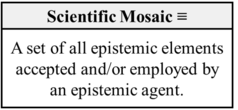Modification:Sciento-2018-0009
Accept the new definition of scientific mosaic as a set of all epistemic elements accepted and/or employed by the epistemic agent.
The modification was suggested to Scientonomy community by Hakob Barseghyan on 8 October 2018.1 The modification was accepted on 17 May 2020.
Contents
Preamble
The current definition of scientific mosaic is flawed in at least two ways. Its most obvious deficiency is that it is not compatible with the new scientonomic ontology suggested in the same paper,1 where questions are a distinct class of epistemic elements. Thus, if the new ontology becomes accepted, the current definition of scientific mosaic as a set of all accepted theories and employed methods will also have to be changed to reflect this new ontology. Yet, there is a more systematic flaw with the definition – the fact that it has the types of epistemic elements hard-wired in it. The Laws of Scientific Change didn’t have a special discussion of the ontology of scientific change, but introduced the two basic elements of the initial scientonomic ontology through the definition of scientific mosaic.2p. 5 This is problematic, as any ontology of any field is not merely a set of definitions of entities and relations, but also a set of descriptive propositions stating which of those entities and relations actually exist. For example, the ontology of the standard model doesn’t merely define what it means by fermion, boson, quark, or lepton, but also tells us that these types of subatomic particles populate physical reality. Unlike the definitions of quark, lepton, or boson, these descriptive propositions are contingent, i.e. they are hypotheses about the structural elements of physical reality. Similarly, when we say that “questions and theories are the two fundamental types of epistemic elements”, we are suggesting a hypothesis about the structural elements of our domain, i.e. we are making a descriptive claim about theories and methods which is not the same as simply defining these concepts. Thus, an ontology cannot be postulated through definitions.
The suggestion is to redefine the concept of scientific mosaic to (1) ensure that questions can also be part of a mosaic and (2) do it without making any descriptive claims concerning the ontology of epistemic elements, as was the case with the previous definition.
Modification
Theories To Accept
- Scientific Mosaic (Barseghyan-2018): A set of all epistemic elements accepted and/or employed by an epistemic agent.
Theories To Reject
- Scientific Mosaic (Barseghyan-2015): A set of all accepted theories and employed methods.
Questions Answered
This modification attempts to answer the following question(s):
- Scientific Mosaic: What is scientific mosaic? How should it be defined?
Verdict
The modification was accepted on 17 May 2020. Initially, the modification raised an objection from Patton who argued that the modification "is not acceptable at present, because it contains a term; epistemic agent, which has not yet been defined within scientonomy".c1 This objection received two counterarguments. According to Barseghyan, the lack of such a definition of epistemic agent should not "be taken as a reason for postponing the acceptance of the definition of scientific mosaic", since inevitably any taxonomy contains terms that "rely in their definitions on other (yet) undefined terms".c2 This point was seconded by Rawleigh who argued that the definition of scientific mosaic is to be accepted regardless of whether there is an accepted definition of epistemic agent, since "it's de facto accepted already that some agent is required to have a mosaic".c3 In early 2020, Patton dropped his objection as he found that there was "sufficient general understanding of what an epistemic agent is to accept this definition of the scientific mosaic, even without first accepting a definition of epistemic agent".c4 Additionally, Rawleigh argued that the definition is to be accepted since we have "already accepted the revised question-theory ontology".c5
Click on the Discussion tab for comments.
References
- a b Barseghyan, Hakob. (2018) Redrafting the Ontology of Scientific Change. Scientonomy 2, 13-38. Retrieved from https://scientojournal.com/index.php/scientonomy/article/view/31032.
- ^ Barseghyan, Hakob. (2015) The Laws of Scientific Change. Springer.
